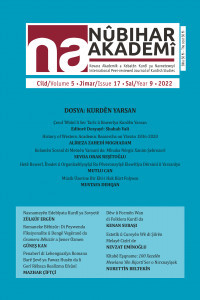The Role of Naqshbandiyah in Development of Barzan Movement
Naqshbandiyyah, Kurdistan, Barzan’s Sheikhs, Mola Mostafa Barzani, Molana Khalid Naqshbandi
The Role of Naqshbandiyah in Development of Barzan Movement
Naqshbandiyyah, Kurdistan, Barzan’s Sheikhs, Mola Mostafa Barzani, Molana Khalid Naqshbandi,
___
- ‘Elî Resûl, Ca‘fer (2008). Sûfîzm û Te’sîrê An ber Cunbuşê Azadî Millî Miletê Kurd. Silêmanîye.
- Algar, Hamîd. (2018). Neqşebendiye. (Dawid Wefai). İntişarat: Moly, Tehran.
- Barzanî, Mes‘ûd. (2020) Beray Tarîx (bêmêjû). Naşir: Roksana, Erbîl.
- Bedlîsî, Emîr Şeref Xan. (1343). Şerefname Tarîxê Mufesselê Kurdistan, cild yek, muqeddîme û te‘lîqat: Mihemed Ebbasî. Intîşarat: Binyadê Daîretu’l-me‘arifê İslam, Danişnameyê Cihanê Îslam.
- Bruînsen, Martîn Van. (2013). Cami‘eşinasîyê Merdomê Kurd (Axa, Şeyx û Dewlet) Saxtarîhayî Îçtima‘î û Siyasîyê Kurdistanê. (Îbrahîm Yunsî). Naşir: Panîz.
- Celîl, Celîlê (1987). Qiyamê Kurdha der Salê 1880. (Kawis Qeftan). Çapxane: El-Zeman, Bexdad.
- Dehnawî, Nizam ‘Elî. (2017). Îrtibatê Neqşibendiye Şibîhqare ba Neqşibendiyê Kurdistan û Perakendegî Anha de Împaratorî ‘Usmanî (nîmê nixust sede 19em), Du Fesilname Mutale‘at Şibeqare. Naşir: Danişgahê Sîstan û Belûcistanê, sal 10em, şimare 35, payîz û zimistan.
- Dehqan, ‘Elî. (1348). Serzemînê Zerdeşt Avda‘ê Tebî‘î, Siyasî, Îqtîsadî, Ferhengî, Îçtima‘î û Tarîxî, Ridaîye, çapa ewwel. Întîşarat: Îbnê Sîna.
- Derwîşyan, ‘Elî Eşref. (2000). Xatiratê Seferxan (Seferê Qehremaniyan) Sî û Du Sal Muqawemet der Zindanhayê Şah. Neşir: Çeşme.
- Eseserd, Ferîd, (2012). Rîşe Endîşe û Bawerî Barzanîha. Naşir: Merkezê Tehqîqatê Istiratejîkê Kurdistan. Esnadê Lane Casusî. 1290 h. q. karton 14, pervend 8, c 31, s 138.
- Ferhadî Manfard, Mehdî. (1377). Pizûheşî der Dîdgaheha Tekapûhayî Siyasî Xwace Nasereddîn ‘Ubedullah Ehrar, Fasilnameyê ‘Ilmî–Pizûheşî ‘Ulûmê Insanî. Naşir: Danişgahê El-Zehra, sal heştem, şimare 26 û 27, tabistan û payîz.
- Ferhoşî, Behram (2012). Karname Ardeşîr Babakan, çapa suvem. Întîşarat: Danişgahê Tehranê.
- Fethullah, Cercîs. (2001). Mebhesanê Elî Hamiş Sevre’ş-Şeyx ‘Ubeydullah El-Nehrî, t 2. Naşir: Aras, Erbîl.
- Hedretî, Hesen û Qenberî, Sebah. (2014). Hikûmetê Derawêş der Kurdistanê Iraqê (1918-1931), Naşir: Neşrîyye Mutale‘atê Tarîxê Îslamî, şimare 27, zimistan.
- Jwaideh, Wadie, (2006). The Kurdish National Movement, Its Origins and Development, First Edition, Syracuse University Press. New York.
- Khalfin, N.A. (1963). Borba za Kurdistan. Moskova.
- M. S. Lazaref; Ş. X. Mihoyan; E. İ. Vasilîyeva; M. E. Gasratyan; O. İ. Jîgalîna (1999). Tarîxê Kurdistanê. mutercîman: Mensûr Sidqî û Kamran Emînava, Întîşaratê Firûx, Mosko.
- Medres, ‘Ebdulkerîm. (1979). Yad Merdan, cildê ewwel, Mewlana Xalid Neqşibendî. Çapxane: Mecmû‘ê Ilmî Kurdê Bexdadê.
- Mehmûd Kerîm, Xalid. (2012). Dewletê Usmanî û Eşîrehay Kurd der Kurdistanê Cenûb (1914-1869). Silêmanîye.
- Melekara, ‘Ebbas Mîrza. (1361). Şerhê Hal Ebbas Mîrza Melekarabe koşiş ‘Ebdul Huseyn Nevayî. Întîşarat: Babek, Tehran.
- Merdûx Rûhanî (Şîva), Baba. (1382). Tarîxê Meşahîrê Kurd, cild 3 (bexşê duvem). Tehran: Sirûş.
- Muîn, Mihemed (1391). Ferhengî Farsî, cilda pêncem. Întişaratê: Emîrkebîr.
- Nîkîtîn, Basil. (1967). El-Ekrad Beyrut.
- Nîkîtîn, Vasîlî. (1366). Kurd û Kurdistan. (Mihemed Qazî). Întîşarat: Nîlûfer.
- Nîşabûrî, ‘Ebdul Ewl. (1372). Melfûzat Xwace ‘Ubeydullah Ehrar, Rîsaleê Doktorî ‘Arif Noşahî. Naşir: Kitabxaneyê Merkezî Danişgahê Tehranê.
- Reşadî, Kamil, (2018). Tarîxê Temeddunê Kurd ez Eyyûbiyan Ta Siqûtî Împaratorî ‘Usmanî (Qerardad Saykis-Piko). Întişarat: Şefi‘î, Tehran. Rîsale el-Rabite, Mecmû‘ê ‘Ezîme fî Esrari’l-terîq, Istanbûl.
- Tavakolî, Muhemmed Reûf. (1359). Tarîxê Tesewwif der Kurdistanê. Naşir: Tavakolî.
- Teferşiyan, Ebulhesen (1359). Qiyamê Efseranê Xorasanê. Naşir: ‘Ilim.
- Voldebîgî, Behram. (1395). Ber Tarîkê Tofan: Mela Mistefa Barzanî be rîwayetê metbû‘atê Îranê 1358-1324. Naşir: Salis.
- Voll., John, (1975). Muhammad Hayya al-sindi and Muhammad ibn abd al-Wahhab: an Analysis of an Intellectual Group in Eightcenth-Century Medina. Bulletin of th the school of Oriental and African Studies. XXXVIII:I.
- Zarînkob, ‘Ebdul Huseyn. (1353). Arzeşê Mîrasê Sofye. Tehran: Întişaratê Emîrkebîr.
- Zekî Beg, Muhemmed Emîn. (1370). Tarîxê Silêmanîye û Anhaîha. (Muhemmed Cemilbendî Rojbiyanî). Bexdad.
- Ziyare’l-mazî el-qerîb. (1998). Dar el-şems el-teba‘et we’l-neşr, Stokholm.
- ISSN: 2147-883X
- Yayın Aralığı: Yılda 2 Sayı
- Başlangıç: 2014
- Yayıncı: PAK AJANS Yayıncılık
Wateya Peyvên “Kurd” û “Goran” di Metnên Dînî yên Yarsan De
The Role of Naqshbandiyah in Development of Barzan Movement
Mohammad HAJİTAGHİ, Behzad AHMADİ
Loristan Atabegler Hükümetine Dair Bir Değerlendirme
Çevirmen: Cumhur ÖLMEZ, Çevirmen: İbrahim TARDUŞ
Rewşa kurdî ya Sosyolenguîstîk li Tirkîyeyê
رێكێن دروستكرنا تێرم و تێرمێن زانستی و بكارهینان ئهوان د ناڤ زمانێ كوردیدا
Goran, Kurd, and Hewramani Relations at the Heart of the Manuscripts
